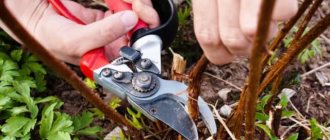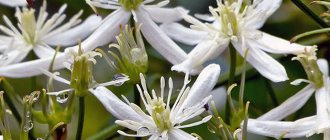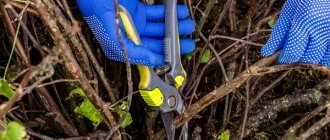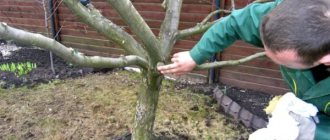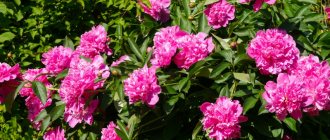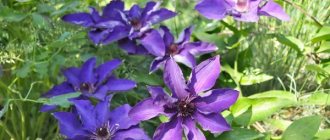Rules and terms for transplanting chokeberry to a new place
Chokeberry is an ornamental fruit plant that has medicinal properties. By carrying out autumn activities, the bush is prepared for winter and for good fruiting next year. But the plant does not have to be grown in the same place. It can be transplanted to a new site. Knowing the basic rules for replanting chokeberry will allow you not to harm the bush and preserve its fruiting.
How to care for chokeberry in the fall
A set of activities carried out in the garden in the fall is aimed at successful wintering of plants. For chokeberry, the main needs are light and moisture, the absence of harmful insects and diseases. A resilient culture can handle other tasks on its own.
Basic care for chokecherry in the fall:
- Trimming.
- Pre-winter watering.
- Prevention of infections.
- Fertilizer application.
Chokeberry berries ripen late. Depending on the climate, they are harvested from the beginning of autumn until frost. Immediately after picking the berries, care work begins. In areas where chokeberries are already collected from under the snow, all activities must be carried out before harvesting.
Chokeberry does not require specific methods for autumn care. All of them are known to gardeners from other fruit crops. However, each stage has its own characteristics and should be considered in more detail.
Why do a transplant?
Chokeberry can withstand winter frosts well, has high immunity to diseases and is not picky about climatic conditions.
But to obtain a high yield and normal growth of the bush, you need to select comfortable conditions. Replanting the rowan tree to another place is not necessary. But there are some points that push for this procedure. These include:
- The rowan began to produce a weak harvest.
- A heavily shaded area where a bush grows or poor soil.
- A cherry tree grows nearby. They have common pests that attack two trees at once.
The optimal time for transplantation is early spring or mid-autumn, while the temperature remains above 10 °C. If the procedure is done correctly, the bush will easily tolerate transplantation, regardless of its age.
Processing chokeberry
Growing and caring for chokeberry requires preventive treatments against pests and diseases. They are carried out in early spring, before the buds open: the bush is sprayed with one percent Bordeaux mixture. In the fall, after leaf fall, autumn preventative treatment of chokeberry is carried out, using the same drug or similar ones. Instead of Bordeaux mixture, you can treat with a seven percent urea solution - this way you will take preventive measures and feed the bush with nitrogen fertilizer.
Latest articles about gardening
Perennial chrysanthemums planting and care in open ground
Sheltering a peach for the winter
Thuja: planting and care at home
Optimal time for chokeberry transplantation
Rowan can be replanted in spring or autumn. It all depends on the climatic conditions of the region where the shrub grows. For example, in the central regions this is done at the end of September – beginning of October. In the northern part they are transplanted in September, and in the southern part - in October. In the southern regions, spring transplantation is also permissible, when there are no night frosts.
Autumn replanting is easier, since stronger bushes are able to recover faster. To make them take root faster, cut the side shoots in half and thin out the foliage. In the spring, all the energy of the rowan goes to the formation of green mass. And replanting will be very stressful for the root system, which may not be able to cope with the double load.
Autumn transplant
Chokeberry is transplanted to a new location in the fall in early October. As soon as the leaves of the bush fall, it enters a period of biological dormancy. At this time the work is carried out.
To do this, carefully cut out a large lump of earth around the trunk. The larger it is, the less likely it is to damage the root system. The immersion depth of the shovel must be at least 50 cm. After this, the lump is separated from the main soil and raised. The new hole is made slightly larger than the dug hole. Before replanting the chokeberry to a new location, fertilizing in the form of superphosphate and potassium fertilizer is added to the hole. This will allow the plant to take root more easily.
Spring transplant
Chokeberry is also transplanted to a new location in the spring. At this time, the main thing is to follow the basic rules and features of the procedure. This is done in mid-spring (late April). Spring planting allows you to select and prepare the site in advance. The tree will have time to gain strength over the summer and will withstand severe winter frosts.
But in the spring the plant will need increased care, regular watering and fertilizing. After the procedure, the rowan will not begin to grow immediately and will produce a harvest only next summer.
How can you propagate chokeberry in the fall?
You can propagate chokeberry in several ways:
- seeds;
- layering or offspring;
- cuttings (green or mature);
- dividing the bush;
- vaccination.
Not all of them are applicable in the fall. It is often practiced to sow seeds in open ground. Sprouts that appear in the spring should be grown for several years.
Propagating chokeberry by cuttings in the fall is a way to quickly obtain good planting material. For rooting, in September, cuttings are cut from mature 2-year-old branches, about 15 cm long. The cut stems are planted obliquely in a cold greenhouse, leaving several buds above the ground. Rooted cuttings will be ready for planting in a year, in the fall.
Horizontal layering refers to the branches of chokeberry, bent and pinned to the ground, without separation from the mother plant. By carrying out the procedure in the fall, in the spring you can get a good vertical shoot, which is separated from the bush when it reaches 20 cm.
Advantages and disadvantages of autumn transplantation
When replanting chokeberry from the forest in the fall, not only climatic conditions are taken into account, but also the condition of the plant. Autumn planting brings with it positive and negative aspects.
The advantages of transplanting mountain ash from the forest in the fall include:
- after planting, the trees will begin to grow three weeks earlier, unlike in spring;
- less time is spent on caring for shrubs, since the level of soil moisture and temperature is controlled by nature itself;
- saving time, since there is less work in the garden in the fall than in the spring;
- At this time, you can appreciate the root system of the tree and understand how it will develop in the future.
The disadvantages of autumn work are:
- if the region has frosty winters, then there is a possibility of the root system freezing;
- strong winds can damage the bush and break off weak and young branches;
- an attack by rodents is possible, which actively attack the garden in the fall.
Rodents may not completely destroy the tree, but they will prevent it from blooming in the spring. This means there will be no harvest.
Caring for chokeberry in autumn
After pruning chokeberry in the fall, it is necessary to carry out subsequent care. At the end of the work, the cut branches are taken out of the area and burned. Pests and pathogens that have accumulated over the season are destroyed along with the garbage. Large wounds are covered with garden varnish or oil paint.
Fertilizer is applied after pruning chokeberry only if the plant has not been fed in the previous few seasons. Nutrients are added to the soil in the form of potassium-phosphorus fertilizer.
Chokeberry planting sites
As for mail, the main thing is that it is neutrally acidic and moist. If the acidity is still elevated, then before planting it is treated with lime or dolomite flour. The root system of the shrub is located in the first 0.5 m of the surface, so it is not afraid of the presence of nearby groundwater. It is not recommended to plant chokeberry in places where the soil is highly saline. At low humidity, the berries become dry and small in size.
In order for a tree to bloom and bear fruit well, it needs a lot of light. If there is darkness in the area, then the bush stretches upward. Chokeberry can be planted as a hedge if the side shoots are trimmed correctly, giving it an oval shape.
Types and varieties of chokeberry
Wild chokeberry is considered a weed plant with fruits of little use for food. It grows in places difficult to cultivate. Aronia chokeberry has a large number of varieties, because... lends itself well to hybridization. Some of the varieties are intended for cultivation in the northern regions, some in the southern regions. Among the most popular varieties are:
Viking. Advantages of the variety: frost resistance, large fruits, larger than black currants.
Nero. Advantages of the variety: shade tolerance, frost resistance, berries are the largest among other varieties, highly decorative foliage.
Black-eyed. Advantages of the variety: unpretentiousness in cultivation, immunity to pests and diseases, honey plant, lack of tart taste in berries.
Hugin. Advantages of the variety: winter hardiness, tall growth - up to 2 m, high decorativeness of the bush.
Proper transplantation of rowan in the fall
When transplanting young chokeberries in the fall, procedures similar to planting seedlings are performed. The difference is that a 5-year-old plant is independently removed from the ground before being planted in a new place. When working, do not forget that the root system of the tree is branched, so the excavation radius is taken with a margin so as not to damage the roots.
There are basic rules for replanting chokeberries in the fall:
- The main thing is to choose the optimal time for gardening. Since biological dormancy occurs in the tree in the last month of autumn, the procedure is done at this time.
- It is important to consider the air temperature. At night it should not fall below -15 °C, and during the day it should not fall below -3 °C.
- It is not recommended to touch a tree that is more than 3-4 meters.
- Dig out the root system carefully. The radius of the earthen coma is taken from one meter. The soil is removed carefully, large roots are carefully trimmed. In order not to greatly damage the rhizome, the tree is removed from the hole using levers.
- It is important to preserve the earthen ball on the roots as much as possible. This is done using burlap, which is put on it and dragged onto a thick film. With its help, the plant is carefully moved to a new place with the slightest damage.
- The hole where the tree is planted is made 40-50 cm larger than the earthen clod.
- Three layers of expanded clay, soil and snow are laid out at the bottom of the pit. Each layer is made at least 5 cm. An earthen ball is placed on top and carefully buried.
- The last stage is mulching the soil.
How to plant chokeberry in the fall
Autumn is the most convenient time for planting chokeberry. You can have time to prepare the planting holes, leisurely select seedlings and not worry that unpredictable frosts will destroy the sprouts.
Seedlings that have ripened over the summer are less susceptible to freezing than fresh shoots during spring planting. In autumn, the root system takes root better. Its active development stops only at -4 °C.
To adapt the roots of chokeberry planted in the fall, 20 days before the onset of persistent cold weather is enough. In spring, such a plant wakes up faster and begins to rapidly grow its above-ground part. At this time, spring-planted seedlings are just coming to their senses.
Where is the best place to plant chokeberry in the fall?
Chokeberry grows well in any soil, except highly saline soils. Its root system tolerates high groundwater levels and spring floods well. Therefore, any area with enough sun is suitable for planting in the fall.
Black currants are very demanding when it comes to lighting. In shaded areas, chokeberry can be grown only as an ornamental crop. It will require a lot of light to flower and set fruit.
Planted along the border of the site, from the prevailing winds, chokeberry can serve as protection from drafts for the entire garden or vegetable garden.
Landing dates
The time chosen for work must meet two requirements: not be too warm and not precede frost. By planting chokeberry too early in the fall, when the temperature still rises above +15 °C, you can end up with a developing aerial part rather than roots.
Later, when the air temperature drops more, chokeberry is not inclined to grow branches, but grows its root system. This is especially pronounced if the plantings are mulched in the fall.
Planting dates vary from September to November, vary greatly by region and are selected depending on the climate.
How to plant chokeberry in the fall
To properly plant chokeberry in the fall, you should select and prepare a place in the garden in advance. Planting holes (50*50 cm) are dug in advance to allow the soil to shrink.
The excavated soil is enriched with the addition of humus, wood ash, and superphosphate. Drainage is laid at the bottom of the planting holes: pebbles, crushed stone, broken brick.
The process of planting chokeberries in the fall:
- Water is poured into the prepared holes to ½ volume and wait until it completely goes into the soil.
- A mound of fertile substrate is poured in the center and a seedling is placed on it.
- Having straightened the roots, carefully cover them with soil, avoiding the appearance of voids.
- After spilling water on the seating area, control the subsidence of the soil and add substrate to the edge of the hole.
- The surface can be immediately mulched to retain moisture.
The arrangement of chokeberry in autumn can be arbitrary. The culture tolerates single plantings well. For increased fruiting, maintain a distance of up to 3 m between bushes. As a hedge, chokeberry requires thickening up to 1.5 m and is planted in trenches.
Nuances of landing in the Moscow region and Siberia
Chokeberry grows well throughout Central Russia. The Moscow region is one of the most favorable regions for growing crops. Nevertheless, one should not forget one of the main rules of gardening: choose zoned varieties.
In order not to make a mistake, it is enough to purchase chokeberry from local nurseries. Seedlings grown in similar conditions take root more easily. The most popular chokeberry varieties in the Moscow region: Chernookaya, Viking, Nero, Hugin.
Chokeberry is extremely winter-hardy and can be cultivated as far as the Far North. The varieties zoned for the Urals and Siberia tolerate temperatures down to -20 °C in autumn and -35 °C in winter. The roots can withstand frosts below -10 °C.
At the foot of the Altai Mountains and in Siberia, after planting in the fall, chokeberry seedlings must be mulched, laid on the ground, and covered with earth. It is important to carry out this work at above-zero temperatures, otherwise the branches become brittle. In the Moscow region and central regions of the country, it is enough to sprinkle the roots with a layer of mulch. It is not necessary to cover the above-ground part in the fall.
Preparing rowan for winter
Despite the fact that chokeberry is a cold-resistant plant, transplanted chokeberry is not yet ready to face harsh and frosty winters.
Therefore, she needs help. To do this, the trunk of the plant is wrapped in burlap and secured with spruce branches. This will prevent frost from penetrating the crown. The main thing is to protect the lower part. As soon as snow falls, the trunk is covered with snow from below and throughout the winter, care is taken to ensure that it does not melt and expose the tender areas of the tree. Sunburn can be harmful even in winter. Therefore, the trunk must be painted with whitewash. They save from winter rodents with special preparations and pesticides. They are scattered around the bushes. Fir or pine needles, which are also used as mulch, repel parasites well.
Before the onset of winter, in addition to the above procedures, perform the following:
- Moisturize. The number of waterings of the bush depends on what kind of autumn it is. If it is dry, then one abundant watering will be enough. For a 4-5 year old tree you will need 35 liters of water.
- After watering, loosen the soil well, then mulch. This will allow the root system to breathe and retain moisture in the soil longer. 10-45 cm of covering material will be enough to protect against freezing.
To protect the tree from harsh winters, it is securely covered. If there is little precipitation, then leaves or spruce needles are used. But they don’t leave the trunk open.
Transplanting chokeberry is practically no different from planting a young seedling. Autumn is the optimal period for work. At this time, there is little gardening work, so you can devote all your time to helping and adapting the shrub in a new place. If you follow all the rules for caring for and planting chokeberries, the bush will suffer minimal stress and will delight you with a bountiful harvest next season.
Features of care in autumn and preparation for winter - general tips and recommendations
Like any other plant, chokeberry needs to create the most comfortable environment possible. Before the onset of cold weather, you need to have time to carry out comprehensive care, the quality of which determines the appearance and fertility in the next season. Caring for mountain ash in the fall should include the following elements:
Watering . If the autumn is dry, rowan trees need to be watered regularly. Depending on the size, 2-3 buckets of water are added under the bush, which is poured into a groove made along the perimeter of the rhizome. The next watering is carried out as soon as the top layer dries well.
Feeding . Rowan is undemanding when it comes to fertilizing: if organic matter or complex mineral mixtures were added during planting, then the bush is not fertilized for 2 years. In the future, potassium-phosphorus fertilizers are applied to the bush once every 3-4 years. For one adult bush over 5 years old, add 70 g of superphosphate and 30 g of potassium sulfate or 1.5 buckets of compost or humus.
Important! Since the roots of rowan are located close to the surface, after applying fertilizers, the soil can be dug to a depth of no more than 8-10 cm.
Trimming . Pruning chokeberries in the fall is the most important element of autumn care. To ensure that the bush has a well-groomed appearance and delights with healthy berries, rowan berries are pruned 1 or 2 times a year.
The plant grows so quickly that if left unattended, it fills the surrounding area and stretches up to 3 m in height. Such amateur activity is unacceptable in small summer cottages, where every centimeter counts.
In addition, pruning not only promotes proper plant growth, but also improves fruit set, which is extremely rich in valuable micro- and macroelements.
Mulching . Spruce spruce branches or dry leaves are used as mulching material to cover tree trunk circles. Young bushes are mulched with a layer 10 cm thick. Organic material will not only protect the root system from frost, but will also retain moisture in the ground, which is very necessary for the plant in winter.
Shelter . Chokeberry is an extremely frost-resistant plant that is successfully cultivated even in the Far North. The plant is able to overwinter on its own without shelter even at -35 C.
Rowan replanting in autumn
The timing of planting in the autumn season can be determined by the climatic conditions of the growing region.
In Central Russia, the optimal time for planting is the 15th of September to the 15th of October.
In the south, planting is best done from the first days of October to the first days of November.
In the north, the best time is September days - the first days of October.
In the Siberian and Ural regions, it is most acceptable to plant in the autumn season, since the spring season in these areas is unstable, frosts or intense heat may occur. And the autumn season passes with good temperature conditions and optimal amounts of precipitation.
Rowan, like most other tree crops, is planted after the leaves have fallen.
If the planting time is missed, the seedling is stored until the spring season. In this situation, it is worth using the methods given below; one of them is selected.
Store in the basement
The root system is lowered into a container containing moistened peat, sand and sawdust.
The underground must maintain optimal conditions (temperature within zero to ten degrees, humidity level between eighty-five and ninety percent).
The roots are moistened once every 7 days with an additional volume of water.
Dig in
A hole of great depth is dug and the root system is placed into it at an angle of forty-five degrees.
Next, it is buried in a wet mixture containing sand and peat.
make snow
The seedling is wrapped in moistened fabric material and buried in the snow. In this situation, temperature conditions that are comfortable for him will remain.
When using the latter method, make sure that the plant is not exposed and that the snow layer is constantly thickened.
Transplanting rowan in the fall to a new place: pros and cons
Pros:
- In the fall you can purchase plants at a low cost.
- In autumn, the seedlings will be fresh. For this reason, a good assessment of their health and quality, both leaflets and root systems, can be made.
- Planting in the autumn season causes fewer problems. You will not need to always check the soil moisture level. All this will be done by natural environmental conditions.
- Young trees planted in the fall will begin to grow two to three weeks earlier compared to those planted in the spring.
- Plus, most gardeners love the time savings. There are few gardening activities in the autumn, but spring is considered the busiest season.
Minuses:
- Due to frosty periods in the winter, the roots and tree may freeze.
- In addition, the health of the plant may deteriorate due to strong winds. Young branches may break off.
- The damage is caused by rodents; they can cause damage to rowan trees late in the fall.
Properties of chokeberry: benefits and harms
Chokeberry is a medicinal plant, but you need to remember that its improper use can be harmful.
Medicinal properties, contraindications
Research has shown that chokeberries have greater antioxidant power than other fruits, including grapes, elderberries, blueberries, cranberries, raspberries, blackberries, prunes, cherries, bananas, oranges, apples and pears. Research has shown that antioxidants help reduce the risk of cancer, heart disease, inflammation, diabetes, bacterial infections and neurological diseases in people. They also slow down the aging process.
But not everyone can use it. Due to the high content of ascorbic acid, this berry is contraindicated for people with angina pectoris, hypertension, and thrombophlebitis. This is due to the fact that vitamin C promotes the formation of blood clots. There are other contraindications:
- ulcer;
- hyperacid gastritis.
Planting rowan. Rules
To ensure successful planting of rowan in the autumn and its rapid establishment in a new area, summer residents with experience adhere to important rules.
- The seedlings should look perfect. If the root system is twisted, then the survival rate of the mountain ash will be longer and not as successful; it will have to be planted before cold weather.
- When purchasing planting material with closed roots or a special mesh, you do not need to get rid of them.
- If you missed the planting time in the fall, then the planting is postponed to the spring.
- There should not be an excess of fertilizing.
- Do not feed rowan with manure, as burns and damage to young roots may occur.
- Young rowan is preparing for the cold season.
- A tree planted in the autumn season is tied to a support to prevent it from swaying and breaking during gusty winds.
Propagation of chokeberry by dividing the bush
To get several chokeberry seedlings, you can divide the bush (but not the old one) into parts and plant them. But chokeberry can also be propagated by cuttings. Green cuttings give a higher percentage of rooting. Cuttings are prepared in the same way as already described: 2-3 nodes long, an oblique cut is made from below to increase the area of root formation, and an even cut is made from above the bud.
Cuttings need moisture and warmth. All this can be achieved either by a specially prepared cuttings coated with film or glass - when rooting a sufficiently large amount of planting material, or by using a regular jar that can cover 4 planted cuttings.
But the best and most effective way to obtain a new chokeberry seedling is root shoots. You dig it up, replant it, and in a couple of years you’ll get your first bunch of berries.
The best planting period, in my opinion, is spring. The vegetative period of chokeberry begins very early, therefore, as soon as the soil allows (thaws), the root shoots are immediately dug up and planted. Humus or rotted manure, a handful of superphosphate and potassium sulfate are added to the planting hole (50x50 cm). This is quite enough for the normal development and growth of the plant. In the future, it is not recommended to overfeed the chokeberry - it begins to form a large number of shoots, the berries become smaller, and the harvest deteriorates.
The dug shoot is shortened before planting. Firstly, an undeveloped root system will not be able to immediately provide nutrition to a large shoot, and secondly, pruning stimulates the growth of lateral buds, and the seedling will be more branched.
Planting rowan in autumn
Planting in autumn differs from planting in spring in a large number of indicators. For the survival and good growth of a tree that is planted before cold weather sets in, important rules must be followed.
How to choose seedlings
Before planting, you need to buy healthy planting material.
- The roots should be moist, intact, have three to four main branches, and should be twenty-five to thirty cm long.
- When the seedling dries out, the bark wrinkles.
- Crown development should also be quite good. It is necessary that it has a main conductor and main branches.
When transporting planting material, its root system is wrapped in moistened cloth and placed in polyethylene.
How to prepare a seedling for planting
Before planting the plant, all overdried and damaged branches are removed, and this also applies to the root system of the tree.
To thoroughly moisten the roots, they are placed in a clay mash for two to three hours.
All leaves are removed in order for the rowan to direct all efforts to take root in the new area.
Rowan transplantation and planting: how to choose a site
Rowan is unpretentious and can take root on different types of soil. For better growth and fruiting of the plant, you must follow the rules below.
The optimal soil is loam or sandy loam. The soil should be loose and neutral; it is advisable that a drainage layer be made using expanded clay.
The tree is very light-loving, for this reason the place is not selected in the shade.
The soil must be moist. It is recommended that groundwater should lie below one and a half meters from the ground surface. In general, culture can grow at higher levels.
Autumn planting
The plant accepts partial shade, but yields are greater if planted in well-lit areas with natural protection. The best time to plant a tree or shrub remains autumn, but it can be planted in early spring outside the frost period.
Planting pattern 3.0x2.5. With good care, rowan berries are planted along the hedge, at a distance of 1.5 m between the bushes.
- Dig a hole 4-5 times larger in diameter than the root ball you intend to plant.
- Mix the excavated soil with organic fertilizer, such as rotted manure and peat.
- Place the clump in a bucket of water to moisten the soil and roots of the bush.
- Spread the roots slightly to avoid damage, separate them from each other if they overlap too much.
- Place some organic fertilizer or mixed fertilizer in the bottom of the hole.
- Place your bush in the middle of the hole, carefully straightening the roots at the bottom, taking into account that the root part of the seedling should not be buried.
- Fill the hole with the mixture you prepared (soil + peat + fertilizer).
- Lightly compact the soil.
Preparing rowan for the winter season
Only the planted rowan does not have time to fully become strong before the cold period sets in, for this reason it must be prepared for the winter season. For this purpose, certain work is being carried out.
The trunk is wrapped with burlap, after which insulation is carried out with spruce branches.
The bottom of the trunk needs to be additionally protected; it is buried with snow; make sure that the snow level does not become smaller and does not expose the trunk.
To avoid sunburn, the trunk must be whitewashed.
They protect the trunk from rodents with specialized poisons scattered in a circle near the trunk.
Rowan replanting. Rules
When transplanting a young tree (up to four to five years old), the same actions are performed and the same rules are followed as when planting for the first time. Replanting will differ in that you need to dig the tree out of the ground yourself. When digging, do not forget that rowan has a very branched root system; it is extremely undesirable to cause damage to it.
If you transplant adult specimens, the following rules are observed:
- The optimal time is late in the autumn, when the mountain ash is in its dormant period.
- Temperature conditions during the day should be minus one to three degrees, at night – minus fifteen degrees, no less.
- The crop must grow to three meters or more, otherwise replanting will be difficult.
- The tree is dug up very carefully. First, a ditch is made around the circumference of the trunk, its radius is approximately one meter. Next, you need to carefully remove the soil, and large roots are trimmed. The easiest way to pull a rowan out of a hole is to use levers.
The soil lump that forms on the roots is necessarily preserved. For this purpose, it is wrapped in burlap and laid out on a thick film material or on a sheet of iron. Next, the rowan is dragged to a new area.
The best size of soil coma for a ten-year-old mountain ash is one meter across and sixty cm deep.
The planting hole should be forty cm larger than the size of the soil clod. A drainage layer five cm thick is laid at the bottom of the pit, including expanded clay, soil and snow. This procedure is repeated three times. After this, the rowan falls into the hole and is carefully buried.
Next, the soil is compacted and well mulched.
To avoid the death of a plant in a new area, its direction to the cardinal points is maintained.
Transplanting rowan in the autumn season is the best time. The plant has excellent tolerance to frosty periods in winter. In addition, trees planted in the fall experience rapid growth, therefore, the fruits can be reaped earlier.
Choice of grade and material
Currently, there is a wide variety of varieties of this crop. Rowan varieties are very popular :
- Black-eyed;
- Hakkiya;
- Rubina;
- Viking;
- Kutno.
They are almost the same, but there are slight differences in the taste of the berries and the ripening time.
When choosing a seedling, an important criterion is to purchase a seedling that is well adapted to the conditions of a particular region.
It is better to find chokeberry from a local nursery or use one planted in a neighboring area as a mother plant.
A one- or two-year-old bush is planted. Quality indicators must be good. The height should be up to 1.3 m, the bark should be without damage and signs of disease, the taproots should be well developed, up to 25 cm long, with a large number of overgrowing roots.
In the middle zone, chokeberry remains in a productive state for up to 30 years. Characterized by stable high yields.
For one family, it is enough to have no more than 2 specimens entering the fruiting period in the 2nd or 3rd year.
Planting chokeberry correctly
Chokeberry in Russia is often called chokeberry, but these crops are not close relatives; they are united only by belonging to the same family - Rosaceae. It is grown everywhere as an ornamental, fruit and medicinal plant. It’s not for nothing that the name of the bush is translated from Greek as “help”, “benefit”.
Planting aronia chokeberry fruit bush
Chokeberry or chokeberry is a well-known plant in many parts of Russia and abroad. The unpretentious shrub is used not only to produce healthy and tasty fruits, but also for landscaping. By autumn, green foliage in summer is colored in all shades of yellow, golden, red, in the form of single plantings or a living wall, perfectly decorating the area.
Aronia chokeberry - beauty and benefits
Aronia chokeberry is a shrub that grows up to 3 m in height. It is winter-hardy, highly branched, and has a shallow root system . Young plants are quite compact, but over time the crown can grow to 2 or more meters in diameter. Chokeberry blooms in late spring or early summer with white or pinkish fragrant flowers that attract a large number of insects. The fruits are purple-black with a bluish bloom and ripen in late summer. In September, chokeberry leaves turn purple-red. Against their background, black bunches of berries look beautiful, which are recommended to be collected after the first frost.
Photo gallery: chokeberry is beautiful in all seasons
Confirmation that the fruits of chokeberry are valuable and beneficial for the body is their inclusion in the list of medicinal substances by the Ministry of Health.
Aronia berries contain a lot of iodine, as well as rutin, which increases the elasticity of blood vessels and slows down the aging process. They are useful for high blood pressure and help speed up the treatment of nervous and cardiovascular diseases.
The usefulness and beauty of chokeberry are undeniable and indicate in favor of its cultivation in garden plots.
Care for chokeberry
Chokeberry, whose medicinal properties are valued all over the world, is unpretentious in care.
How to care in spring
In spring, chokeberry requires sanitary and formative pruning. In addition, whitewashing with lime is required. All this needs to be done at the end of March - beginning of April.
Weeding is also carried out regularly immediately after weeds appear.
How to care in summer
During the summer care of chokeberry, all attention should be paid to the fight against harmful insects, even if prevention was previously carried out. You also need to monitor the health of the chokeberry, and when the first symptoms of the disease or the appearance of pests appear, treatment should be started immediately.
The peculiarity of chokeberry is that it is resistant to dry weather, but it should not be allowed to dry out the soil. If the summer is not rainy, the plant needs to be watered and the soil loosened.
Autumn care
The fruits of chokeberry, the benefits of which no one doubts, ripen at the end of summer, but it is recommended to collect them after frost. Therefore, in the fall, the plant must be gradually prepared for the dormant period, in particular, sanitary pruning and treatment are needed.
Young plants need to be hilled up and covered with dried leaves. Mature bushes do not need to be covered.
Processing chokeberry
Preventive treatment is carried out at the end of March - at the beginning of April. The purpose of its implementation is to protect the bush from pests and pathogens that could survive the winter and remain in the chokeberry bark and in the surface of the close circle.
Other processing with specialized means is also possible. This treatment is carried out until the first buds open. Spray the plants with a 1% solution of Bordeaux mixture.
Trees are also treated in the fall, but with a 7% urea solution. Such actions will destroy all pests that will not overwinter with the chokeberry.
Watering chokeberry
This plant grows well without frequent watering, but with such care the berries will not be large. To avoid this, you should still water the rowan once a week, but only in dry weather.
Fertilizer
Apply a balanced, slow-release fertilizer annually, if desired, to stimulate plant growth. Fertilizer is often not necessary for a chokeberry bush, especially if nutrient-rich amendments are made to the soil before planting and organic mulch is used around the bush.
As for phosphorus and potassium, they can be applied under chokeberry every two years at the height of summer, after the soil is well loosened and moistened. Under each tree you need to add a tablespoon of potassium sulfate and superphosphate.
Landing
If you decide to grow this beautiful and useful plant on your plot, then you need to know when, how and where it is preferable to do it.
When to plant chokeberry
There is no clear answer to the question of when it is better to plant chokeberry: in autumn or spring. It all depends on weather conditions, soil quality, the gardener’s availability of free time and other factors. Each season has its pros and cons that must be taken into account when making a planting decision.
Autumn planting
Autumn is a great time to plant chokeberries. The optimal planting time is from late September to early November. They can be called floating, since it is necessary to take into account the characteristics of the climatic zone and weather conditions. The main guideline for starting planting is the plant’s entry into a state of biological dormancy, which occurs after the leaves fall from the bush. Advantages of autumn planting:
- benefit. In autumn, seedlings of the crop are more affordable in price and variety of varieties;
- ease of landing. Autumn planting does not cause much trouble. After planting, the plant is watered, and then nature takes over;
- comfort. The plant itself will be dormant, but before the onset of frost it will have time to grow thin, absorbent roots. Autumn humidity and temperature conditions are comfortable for this process. In addition, during the winter the soil around the seedling becomes compacted, so autumn plantings begin to grow much faster than spring ones;
- saving time. In the fall, gardeners have much less trouble than in the spring.
Disadvantages of autumn planting:
- chokeberry seedlings can be damaged by severe winter frosts, especially in northern regions;
- In addition to frost, winter threatens seedlings with other troubles: icing, strong winds, snowfalls. They can break a young plant;
- in late autumn and early winter, rodents become active and can damage the roots of seedlings.
Rodents can damage chokeberry seedlings planted in autumn
Spring planting
The plant tolerates spring planting well. The main thing is to carry it out in compliance with all the features of the procedure and early enough - before the end of April. Spring planting has its positive and negative aspects. The advantages of planting chokeberry in the spring include the following:
- in the spring, when planting is being planned for the current year, you can prepare planting holes in advance, since the area is practically free of other plants, there is no need to wait for harvesting and the release of the planned place;
- although the plant will begin to grow later, it has a whole growing season ahead of it, which means it can get a harvest next summer. If you delay planting until autumn, the fruiting of the crop will be delayed for the whole season.
Disadvantages of spring planting chokeberry seedlings:
- increased attention and care. Spring seedlings need to be watered regularly, especially if the spring is windy and dry;
- lack of good planting material;
- In the spring there is much more work in the garden and vegetable garden than in September - October: preparing the soil, growing seedlings and caring for them, sowing vegetables and other important activities.
Where to plant chokeberry
Chokeberry is a perennial plant; it can grow well and bear fruit in one place for up to 30 years, so you should approach the choice of a site for planting with all responsibility.
The best predecessors for chokeberry are perennial grasses and green manure.
Chokeberry is undemanding to soil. The plant is preferably planted on moist loamy soils with neutral acidity. But at the same time, it will grow normally on soils with high acidity, pre-treated with dolomite flour or lime, as well as on sandstone. Chokeberry does not suffer from close groundwater, as it has a superficial root system located no lower than half a meter from the surface. Chokeberry grows poorly only on highly saline soils. However, in areas with insufficient moisture, chokeberry berries may be small and dry.
Aronia chokeberry is undemanding to the soil and grows poorly only in saline soil.
For excellent flowering and an abundance of fruits, the crop requires good lighting. With strong shading, including internal shade, the bush will stretch upward excessively. Chokeberry goes well with garden and vegetable crops.
It is not recommended to plant chokeberries next to cherries, as these plants have common pests: slimy sawfly and aphids.
Chokeberry is often used to organize hedges, as well as for group plantings. The grafted chokeberry can be shaped into a ball and will serve as an original decoration for the site if you use mountain ash or hawthorn as a stem.
A chokeberry hedge has a beautiful appearance, a dense crown, low growth and is easy to trim and care for.
Landing rules
The methodology for planting crops in autumn and spring is identical. When planting chokeberry, it is important to have healthy seedlings. When choosing them, first of all, it is necessary to take into account the condition of the root system.
Dry, weathered roots indicate that the plant will not take root well and will be sick for a long time.
If there is a need to transport seedlings, they must be carefully covered, protecting them from drying out and freezing. Immediately before planting, it is recommended to inspect the seedling, remove dried and damaged roots and shoots, and then dip the root system in a mash of clay, water and manure.
Planting is best done in the evening in cloudy weather. The planting holes should be about half a meter in diameter and depth. If you are planting several plants, you should ensure that the feeding area for each is approximately 2x3 meters. The soil mixture for backfilling the seedling includes the following elements:
- topsoil and humus (1:2);
- superphosphate (150 g);
- wood ash (300 g).
The process of planting chokeberry includes the following steps:
- The prepared mixture is used to fill the third part of the planting hole.
- Add fertile soil, filling the hole to half its volume.
- Water using at least 10 liters of water.
Before planting the seedling, the soil in the planting hole is watered
When planting a shrub, the root collar is buried into the soil by a maximum of 1.5–2 cm and the soil is compacted tightly
If the seedlings had a well-developed root system, then the above-ground part of the plant after planting does not need to be cut off. Otherwise, it is recommended to trim the shoots, shortening them to 15–20 cm and then making sure that a few healthy buds remain on them.
Video: instructions for planting chokeberry
How to prune chokeberry in the fall
The main work on the formation and rejuvenation of the bush is carried out in the spring, when it is possible to assess the condition of the plant after wintering. Pruning chokeberry in the fall is guided by other goals.
The vigor of chokeberry growth causes stems and lateral shoots to appear throughout the growing season. By autumn the middle of the bush thickens and stretches upward in search of light. This chokeberry is susceptible to disease; fruits are set only on the side shoots.
You can thin out the plant throughout the season. In summer, if possible, remove thin and thickening shoots that take away the strength of the plant. In the fall, other chokeberry problems that require intervention may be discovered:
- the appearance of leaves affected by infections;
- broken branches, dried shoots;
- areas of burst bark on mature trunks;
- an abundance of root shoots that thicken the bush;
- accumulations of insects seeking to overwinter in the soil.
You need to leave the chokeberry bush over the winter cleaned and thinned. In all of the above cases, pruning is mandatory.
Detailed instructions for planting, caring for, and pruning chokeberries in the fall and spring in a video from an experienced gardener.
When to prune chokeberry: in autumn or spring
Spring is rightly considered the main time for pruning in the garden. Before sap flow begins, chokeberry must be carefully examined and all dead branches removed. Frostbitten areas are shortened to live, green wood. It is also convenient to form bushes in the spring, before the rapid growth of chokeberry begins.
At the end of the season, it is impossible to do without an audit of the plantings. Chokeberry bushes grow strongly by autumn. Thickening and multiplying insects can harm the plant in winter, which will stop the development of the bush when it gets warmer. Fungal infections from branches that were not harvested in time, after overwintering, attack healthy chokeberry stems in the spring.
Sanitary pruning is appropriate at any time. Thickening or diseased chokeberry branches should be cut out immediately after the problem is discovered: in spring, summer or autumn, excluding only the period with sub-zero temperatures.
Pruning chokeberry in the fall for beginners
It is important to prune chokeberries long before frost. Cuts and wounds on branches and trunks should heal or dry out, which will prevent them from freezing. Pruning times vary in different regions. You should focus on the average annual temperatures in a particular area, approximate time: September - October.
Advice! If the date of frost is unknown, or the cuts on the chokeberry are large, you should treat the wounds with garden varnish.
The formation of the bush is carried out in the spring. When planting chokeberry in the fall, it is also not recommended to shorten young shoots; this increases their vulnerability to frost and disease. It is better to form overwintered shoots after the snow has melted.
Sanitary pruning in the fall involves removing thin, thickening shoots growing inside the bush. Chokeberry branches affected by diseases are cut out completely. It is advisable to make cuts below soil level. Stumps left above ground often become a haven for insects and a breeding ground for infections.
If there is a need to rejuvenate chokeberry in the fall, cut out no more than half of the skeletal branches. The rest can be shortened. Experienced gardeners recommend radical rejuvenation by completely cutting off the entire bush in the spring.
Comment! All plant residues after pruning chokeberry must be collected and burned. You should not leave fallen leaves in the tree trunk circle. With them, pest larvae penetrate into the ground and overwinter in the soil.
Treatment of chokeberries in autumn against pests and diseases
Most chokeberry diseases are fungal in nature. They can be treated and prevented with copper-containing compounds. The most common, proven preparation for spraying in the fall is Bordeaux mixture at 1% concentration or copper oxychloride.
Before processing, you should carefully examine the plant, if necessary, remove diseased shoots and dispose of them. A solution of copper sulfate also helps prevent the appearance of chokeberry pests. Such spraying in the fall can be called universal.
The exception is brown mites that parasitize chokeberries. If they are detected, spraying with special acaricidal agents will be required: Karbofos, Kleschevit, Apollo, Tedion.
Cherry sawfly, rowan moth, other beetles, butterflies, which lived in the crown and on fruits all summer, fall to the ground in the fall with fallen leaves. The larvae overwinter in a layer of plant debris or move into the ground. The only way to prevent pests from being carried into the next season is by collecting all the fallen leaves and removing them from the area. The chokeberry is then sprayed and the soil is mulched with uninfected material.
Transfer
Sometimes on a site there is a need to transplant an adult chokeberry bush to a new location. It is better to do this in early spring, before active sap flow begins. If you can do without dividing the bush, then it is optimal to replant with a lump of earth.
- A trench 25 cm wide and about 50 cm deep is dug around the bush.
- Using a crowbar or shovels, lift the roots along with a lump of earth and move them out of place.
When transplanting an adult plant, dig it up and carefully drag it along with a lump of earth to a new place.
If desired, an adult plant can be divided into several parts. In this case, you should lightly clear the root system of the soil, then use an ax or other sharp tool to divide the bush. Each division should have young, healthy roots and several strong shoots. The cut areas are sprinkled with charcoal. Then each part is planted in its intended place.
In the spring, before sap flow begins, a chokeberry bush is dug up, all old branches are removed from it, the root system is cleared of soil and, if necessary, divided into parts
After replanting, the bush must be inspected, old, dry branches must be cut off, coating the cut areas with charcoal. This procedure helps to rejuvenate the chokeberry and reduce the load on the established root system.
Experienced gardeners note that chokeberry transplants are painless and produce a good harvest the following season.
Diseases and pests
In order for chokeberry to quickly begin to grow with the onset of spring, it is recommended to carry out disease and pest prevention in the fall.
- In order to prevent moniliosis, septoria and peripheral wood rot, rowan is sprayed with one percent Bordeaux mixture or copper oxychloride.
- In the fight against a fungal disease called comb fungus, the plant is sprayed with the same Bordeaux mixture and severely affected branches are cut off.
- Rowan moth and cherry slimy sawfly are insects that harm rowan fruits and leaves. Thorough cleaning will help protect the plant from pest attacks next year: raking dried leaves near the rowan tree and burning them. Along with organic waste, most of the pupae that hid for the winter are also destroyed.
- You can get rid of brown or red mites by spraying rowan with Karbofos, Tedion, Kleschevit or other preparations designed to combat insects.

